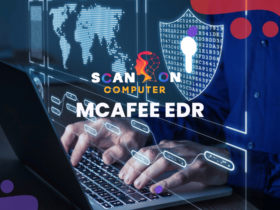Endpoint Detection and Response (EDR) security tools assist with investigating incidents that bypass your EPP or other prevention measures, providing visibility into all activity on endpoints to minimize dwell time for attackers.
Basic EDR tools offer only data aggregation and analysis; more advanced ones utilize machine learning for automated detection and alerting as well as forensics for investigation purposes.
EDR Definition
EDR (Endpoint Detection and Response) solutions on the market provide a centralized platform for monitoring, detecting, and responding to threats across your organization’s endpoints. Automated responses also make this easier for security teams to quickly contain or eradicate potential risks.

EDR solutions operate by collecting endpoint agent telemetry to a central platform for correlation and analysis, then flagging suspicious activities and taking necessary actions like quarantining an endpoint or blocking processes.
EDR tools combine monitoring, forensics and threat hunting techniques to detect security breaches. By collecting endpoint data and then analyzing it to detect anomalies that indicate how threats entered your system. Furthermore, EDR tools can take automatic measures like quarantining, sandboxing or remote wiping to contain and eradicate threats before they spread further.
Many EDR solutions also integrate with other security systems to allow them to collect and share threat intelligence, correlating endpoint telemetry data with SIEM systems to gain more contextual awareness of potential attacks, speed investigations and trigger automated responses against them; this process is known as incident response automation.
EDR Technology
An EDR solution is a technology platform designed to alert security teams of suspected malicious activity and facilitate quick investigation and response. It utilizes continuous endpoint monitoring technology that records file transfers, activity, and connections – helping businesses detect threats which evade antivirus software while strengthening overall cybersecurity posture.
EDR solutions can provide organizations with essential defense against cyberattacks and mitigate their impacts, whether attackers target remote workers or the business itself. It combines real-time continuous monitoring, endpoint data collection and advanced correlation to detect suspicious activities; with top EDR tools offering forensic capabilities and automated responses based on preconfigured rules to detect incidents more rapidly and respond in the form of automated responses when incidents are detected.
EDR solutions can complement an organization’s existing security tools and platforms seamlessly, such as an endpoint protection platform (EPP). By blocking device-level attacks at the network perimeter with malware filtering or zero-day threat blocking capabilities, these EDR solutions allow teams to spend their time investigating and responding to high-level threats that cannot be prevented using traditional protection tools.
What are EDR Tools?
Endpoint detection and response tools are integral parts of any effective security strategy, helping detect attacks that bypass conventional defenses as quickly as possible, providing visibility into an attacker’s attack timeline so security teams can respond swiftly.
EDR solutions must provide real-time threat detection and incident response capabilities, with automatic incident response capabilities integrated within them. They should also incorporate forensic investigation capabilities for easy integration with existing security platforms.
Additionally, organizations must understand the role of EDR relative to other security solutions like SIEM and firewalls; EDR should act as a complement rather than replace these solutions.
EDR solutions provided as managed services may include teams of security experts who actively hunt down, investigate, and remediate threats in your environment. This approach reduces detection and response times as well as helping focus on the most significant threats to your organization. It’s crucial that EDR solutions be periodically tested to ensure they continue functioning effectively by conducting penetration testing or red teaming exercises to detect weaknesses in defenses.
How EDR Works?
EDR solutions continuously monitor endpoints to detect malicious activity and flag it for further analysis. Furthermore, this solution collects and analyzes data to provide insight into how threats entered the network and caused damage.

The system’s detection capability utilizes cyber threat intelligence to recognize threats that conform with an ever-evolving fabric of tools used by hackers to undermine cybersecurity systems. Additionally, forensics tools provide deeper analysis and investigative capabilities.
Once a threat is detected, EDR solutions take immediate action to address it – for instance temporarily isolating infected devices or sending an alert to members of security team.
Once malicious files are detected, an effective EDR solution can quickly contain them to stop further spread across devices and safeguard an organization by identifying and rectifying any damage done by threats. EDR solutions also help identify and halt adversary attempts at infiltrating and destroying critical assets with greater force; by quickly and accurately responding to threats quickly and accurately an EDR helps minimize damages as well as lost productivity.
Key Components of an EDR solution
EDR solutions typically collect data by installing software agents on each endpoint and monitoring devices through various means. Once collected, this information is sent back to a central platform where it’s processed for signs of threats and analyzed further; alerting authorities if suspicious activity is identified by flagging suspicious activity and providing automated responses such as shutting off an endpoint user or wiping data off their device.
EDR solutions don’t just detect threats; they also provide visibility into adversary activity as they attempt to breach or move around your network. This gives security teams essential insight into where a threat originated and is likely headed next.
Fortinet EDR provides this capability with Real Time Response. It effectively reduces your attack surface, blocks threats that penetrate edge security, and automatically responds to breaches as they happen – as well as working alongside other security layers (email, network, cloud workload) to identify and remediate attacks – giving your network complete coverage without impacting performance.
EDR & EPP
EPP solutions typically include EDR as part of their solution for detection and investigation capabilities to supplement NGAV’s preventative capabilities. A robust EDR system requires technical knowledge as well as active monitoring; an average business professional would likely struggle with managing it alone.
EDR solutions detect threats by conducting in-depth investigations to generate valuable insights for security teams to utilize. Such information includes how the threat breached your perimeter, which vulnerabilities were exploited, etc. With this knowledge in hand, your team can take appropriate measures to prevent future attacks and minimize further damage.
Advanced EDR tools like CrowdStrike provide full visibility into all security activity across endpoints, servers and workloads – giving security personnel full visibility into every security-related action taken against endpoints, servers and workloads. CrowdStrike can effectively “shoulder surf” an adversary attempting to bypass prevention mechanisms by watching their commands and techniques even after being prevented; then relay this data back into your cyber threat intelligence system so protection can be strengthened in future. Furthermore, EDR solutions also offer continuous file analysis to detect threats lurking inside systems – meaning no threats have escaped their system yet!
Why EDR Security Is More Crucial than Ever?
Cyber attackers possess both the motivation and resources to find ways around your security measures, so EDR tools provide an important service in quickly detecting these attacks and responding effectively before any irreparable damage is caused by them.
Basic EDR solutions may offer data aggregation and analysis features, while more sophisticated ones use machine learning to detect suspicious activities and alert on them. An AI-powered tool may analyze MITRE ATT&CK framework to spot patterns of malicious behavior while flagging files as they travel through your system.
EDR tools allow you to isolate threats, so when one is identified they can be examined closely. When necessary steps can be taken against it so as to delete or block its file altogether.
Visibility and speed help mitigate the crippling effects of major attacks. Managed EDR solutions also allow organizations to minimize alert fatigue and burnout among analysts by decreasing alert volumes that need to be reviewed manually.
EDR vs XDR and MDR
How an organization chooses between MDR, EDR or XDR depends entirely upon its security needs. Take into consideration your organization’s business priorities, resources available and cybersecurity expertise when choosing the tool that will best provide visibility and protection of IT assets against real cyber threats.
An EDR solution acts like a DVR on an endpoint, recording activity that would otherwise go undetected, such as processes created, drivers loaded, registry modifications, disk access or memory access. When suspicious files are detected on an endpoint, an alarm alert notifies security teams immediately so they know what’s occurring on it.
While antivirus software may stop certain attacks, an EDR solution can detect those that evade basic protective measures – like malware that silently spreads across networks or ransomware that encrypts files without leaving trace on endpoints or firewall blocks and active directory password resets. With such intelligence at their fingertips, security teams can more rapidly identify threats and investigate them quickly while also automating actions such as blocking download links, removing files from endpoints or firewall blocks or password resets if appropriate.
What Should You Look for in an EDR Solution?
Fast and accurate threat detection on endpoints is crucial to businesses in protecting data, IP, and operational stability. EDR solutions use various techniques such as behavioral monitoring and machine learning to quickly and accurately detect indicators of compromise or suspicious activity on endpoints.
Consider how much expertise will be necessary for your team to operate the solution before selecting an EDR vendor, from extensive training sessions to fully managed services. Also keep in mind whether their sensors are kernel-level or user-space based; kernel-level sensors often require more testing before they have an impactful effect, but can provide greater visibility.
Consider what kind of forensic capabilities an EDR solution provides. These tools allow security teams to analyze past breaches, understand how attackers gained entry, and gain insights into attacker methodologies.
The ideal EDR solution will seamlessly integrate with existing cybersecurity tools, ensuring all defenses are working to protect your organization against attack. Xcitium offers unparalleled visibility over all endpoints while being easy to deploy and use.
Why is EDR Important?
As cyber threats continue to adapt and exploit weaknesses in endpoints, companies must deploy EDR as part of their cybersecurity strategies to protect networks and data. EDR’s threat detection capabilities allow security teams to quickly detect suspicious activity, respond quickly to attacks, and minimize their impact.
As opposed to antivirus and firewall solutions that merely react to known malware threats, an EDR solution employs real-time telemetry from endpoints to identify new and unknown threats and minimize false positives that create too many security alerts for SOC teams to manage.
EDR helps organizations retain information for future reference and provides security tools with access to endpoint, network, and SIEM data that helps provide an overall picture of how attackers gain unauthorized entry. As more organizations employ flexible working arrangements such as remote work or co-working arrangements, having an effective EDR solution in place to protect employees against an increasing number of threats aimed at endpoints is becoming ever more crucial.
Best EDR Tools
Endpoint detection and response (EDR) should be an integral component of your cybersecurity arsenal. As modern threats continue to adapt and bypass preventative measures like antivirus software, EDR provides visibility into suspicious activity while providing prompt and efficient response measures.
Here are several of the top EDR providers.
CrowdStrike EDR is a unified threat detection and response platform with features designed to combat multi-vector attacks, including a Threat Graph which finds potential threats among trillions of security events per day, Zero Trust Assessment, an open API first architecture which makes integration simple with other security tools, and automating incidents detection actions on detected incidents.
CrowdStrike EDR offers organizations an effective solution that provides threat intelligence, contextual awareness, prioritized alerts, containment without impacting endpoint performance – an excellent option for organizations looking to improve their security posture with one agent offering threat intelligence context prioritization prioritization without impacting endpoint performance.
How can EDR security help me?
Employers need EDR solutions that allow employees to securely connect from multiple devices and locations without disrupting security across endpoints. By quickly responding to threats detected in real time, you can help limit potential cyber attacks from being successful in doing their damage.
Modern cyber attacks are increasingly bypassing antivirus solutions that rely on signature detection, making EDR solutions increasingly important to detect unknown threats and reduce alert fatigue by filtering out false positives and only communicating events that require immediate attention.
EDR software analyzes files on your network to detect suspicious activity before it turns into a data breach. They also track malicious files to see if they have been altered and can help restore systems back to normal state if necessary.
An EDR solution with threat intelligence provides context to your alerts, including adversary details and more comprehensive details of ongoing attacks. This enables swift actions that reduce attack duration while quickly returning your organization back to business as usual.
How to Deploy and Use EDR Security?
EDR software can help strengthen your cybersecurity posture and block cyberattacks, but to realize its full benefits you must use and deploy it correctly.
Once you’ve identified the endpoints you wish to protect, install and deploy your tool onto them. Next, monitor and test its deployment in your environment – such as using penetration testing tools – until it works as expected in your network environment.
Once a threat is detected by software, its telemetry is uploaded to a central location – either cloud-based or on-premises – where machine learning algorithms analyze it for anomalies before flagging suspicious activity and initiating automated responses such as isolating endpoints to stop spreading malware infections.
Software such as this can add another layer of protection, detecting threats that traditional antivirus and firewall solutions might miss through behavioral analysis capabilities, providing actionable data on file lifespan and facilitating proactive threat hunting.
How Does EDR Detect Threats?
An EDR solution monitors endpoint behavior and collects information that could indicate security threats. Telemetry collected is then transmitted to a central system – often an enterprise threat detection and response platform or security information and event management (SIEM) solution – where security teams can analyze it and respond effectively to potential threats.
EDR solutions use EDR technologies to detect threats by looking for indicators and techniques used by attackers to gain unauthorised entry to networks, such as their modus operandi, tactics deployed and exploited vulnerabilities. Some EDR solutions also utilize machine learning or artificial intelligence technologies in order to automatically correlate data, identify patterns and detect any potential threats that arise from these methods of attack.
EDR solutions allow organizations to respond rapidly when threats are detected, isolating endpoints and blocking connections immediately; and initiating automated response rules that speed incident containment and remediation activities. By decreasing dwell time – which helps limit cyberattack damage while helping security teams uncover insights about how attacks penetrated their perimeter – EDR solutions allow organizations to take swift action and protect themselves quickly against further incidents.
Managed endpoint detection and response
EDR solutions monitor and record endpoint-system behaviors, alerting analysts of any breaches that might be taking place. By employing machine learning technology to analyze data and create baselines of normal behavior in real time and flag deviations from that pattern in real-time. They also have automated and manual actions available for mitigating threats such as disconnecting devices from networks or wiping and reimaging machines to contain threats more efficiently.
Security teams struggle with managing an overwhelming volume of alerts, with false positives often becoming too much to bear. Implementing managed endpoint detection and response (mEDR) from a security vendor or partner relieves them from managing an in-house solution and allows faster time to threat detection.
Xcitium MDR provides access to leading endpoint detection and response technology, combined with a team of security experts dedicated to hunting down threats round-the-clock. You gain top-level security, enhanced attack detection capabilities, and an increase in SOC productivity with its unified visibility and threat intelligence across devices – giving your business complete protection from cyber threats. Begin a free trial today to see how Xcitium MDR can protect against them! Boost SOC Productivity and Visibility Instantaneously!
Benefits of endpoint detection and response
Endpoint detection and response (EDR) tools alert security teams of suspicious activity on networked computers, providing alerts when malicious activity has bypassed traditional protection mechanisms like antivirus and firewalls. EDR tools offer advanced threat identification capabilities which enable security teams to respond more swiftly than ever.
EDR tools continuously monitor endpoints such as employees’ desktops or laptops, servers, cloud systems, mobile devices and IoT products to provide security teams with valuable telemetry that allows them to detect attacks that have already taken place as well as any new attacks that might arise in real-time. Telemetry collected by these tools enables security teams to investigate and contain both known as well as potential cyber attacks in progress.
Good EDR solutions shouldn’t burden endpoints with heavy client software; rather, they offer lightweight monitoring capabilities and allow continuous observation without interfering with their functionality.
CrowdStrike customers benefit from full visibility into all security-related activities on their endpoints, such as process creation, driver loading, disk access, memory access and network connections. This gives them real-time “shoulder surfing” of adversaries trying to breach or move around their environment – enabling faster investigation and rapid responses to prevent or contain breaches.













Leave a Reply
View Comments